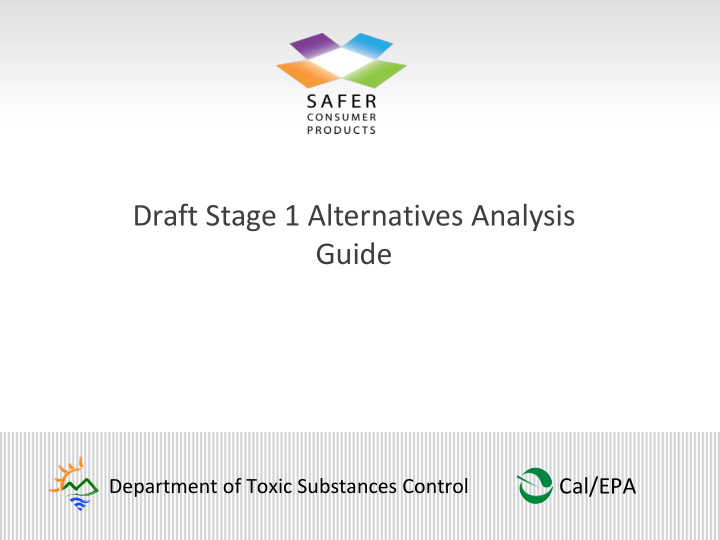



Draft Stage 1 Alternatives Analysis Guide Cal/EPA Department of Toxic Substances Control
Welcome! Reminder - Regulations vs. guidance Helpful Information and resources Decision making – storytelling Not a linear process Please give us feedback 2
About the Webinar Introduce the Guide Solicit comments for the Guide 3
http://www.dtsc.ca.gov/SCP 4
https://calsafer.dtsc.ca.gov/Comments/PackageDetail.aspx? PID=11741 5
SCP Regulations: Four-Step Framework California Code of Regulations, title 22 Chapter 55. Safer Consumer Products sections 69501 through 69510 Alternatives Analysis: Article 5 section 69505
Alternatives Analysis Process 7
About the Guide... The Guide IS: The Guide IS NOT: Regulations Guidance Dynamic Static Multi-purpose for Meant to be used solely multiple audiences as a step-by-step guide A checklist A menu of options 8
About the Guide… 9
Differences between SCP and Other AA Frameworks Specific list of relevant factors Economic Impacts • Public Health and Environmental Costs • Costs to Government and Non-Profit Organizations Mandatory Life Cycle Consideration Not Limited to Chemical Substitution No Requirement to Generate New Data 10
How Guide is Organized - First Stage AA Chapter 1 – AA Framework Chapter 2 – Product Requirements and Alternatives Chapter 3 – Relevant Factors Chapter 4 – Impact Assessments Chapter 5 – Screening Alternatives Screening Analysis 11
How Guide is Organized - Second Stage AA …..Under development Chapter 6 – Exposure Assessment Chapter 7 – Life Cycle Impact Assessment Chapter 8 – Economic Analysis Chapter 9 – Information Needs and Transparency Chapter 10 – Alternatives Comparison Chapter 11 – Review and Evaluation of AA Reports In-Depth Analysis 12
Chapter 1: AA Framework Two-stage AA Process Other Compliance Options Appendix: Required Information for AA Reports 13
Chapter 2: Product Requirements Function and Performance Legal Requirements Role of Chemical of Concern Identifying alternatives Appendix: Data Sources for Identification of Alternatives 14
Example: Identifying Product Requirements and Alternatives Product: Paint and varnish removers with Chemical X Product Function: To remove paint or varnish from a particular substrate such as wood or metal, to restore the substrate to its original condition, or to prepare it for new paint or varnish. Chemical X Function: Dissolves paint by bonding to the chemical, causing it to separate from the substrate. Performance : Amount of coating removed based on stripping time; condition of substrate after coating removal Legal: None Alternative products: Should achieve the same function as the Priority Product. Chemical Substitute: Alternative chemical is likely to be another solvent. Alternative Product Design: Sand paper, blasting media, heat guns 15
Chapter 3: Relevant Factors Makes material contribution Material difference 16
Relevant Factors Example 17
Relevant Factors Example Raw Materials Processing Manufacturing Transportation Use Waste Treatment CO 2 Emissions 18
Factors to be Considered for Relevance: Adverse environmental impacts Adverse public health impacts Adverse waste and end-of-life effects Environmental fate Materials and resource consumption impacts Physical chemical hazards Physicochemical properties Associated exposure pathways and life cycle segments 19
20
Relevant Factors to Consider In Second Stage Adverse Impacts and Multimedia Life Cycle Impacts Product Function and Performance Economic Impacts 21
Approaches to Relevant Factors Identification Life Cycle Thinking Iterative Process Exposure Pathways Conceptual Model 22
Conceptual Model – Identification of Relevant Factors 23
ALTERNATIVE CHEMICAL A X Raw Material Extraction Processing and Production 24
Example for Displaying Results of Life Cycle Screening Analysis 25
Chapter 4: Impact Assessments Data Gathering Comparative Tools Appendix: Tools and Methods for Chemical Hazard Assessment 26
Chapter 5: Screening Alternatives Screening Approaches • Consider screening goals • Compare impacts • Identify trade-offs • Reserve marginal alternatives • Document rationale 27
Example of Comparison Approach Group I Human Group II & II Human Ecotox Fate Physic al C M R D E AT ST N SnR IrS IrE AA CA P B RX F Sn S Single repeated Single repeated Chemical X Alternative 1 Alternative 2 Alternative 3 Alternative 4 Alternative 5 28
Summary Menu of Approaches Iterative Preliminary AA Report and Work Plan 29
Alternatives Analysis Process 30
Confidential Business Information Submitted through CalSAFER secure system Two Copies of AA Report: • Redacted • Full (including CBI) Supporting information CBI claims subject to review 31
DTSC wants your feedback Guide is for you! Tools, approaches, methods, data sources Additional examples Clarity Comments through CalSAFER by November 16, 2015 https://calsafer.dtsc.ca.gov/Comments/PackageDetail.aspx?PID= 11741 32
Next Steps Draft Stage 2 AA: Spring 2016 Webinar for Draft Stage 2 AA TBD 33
Thank You! 34
Recommend
More recommend